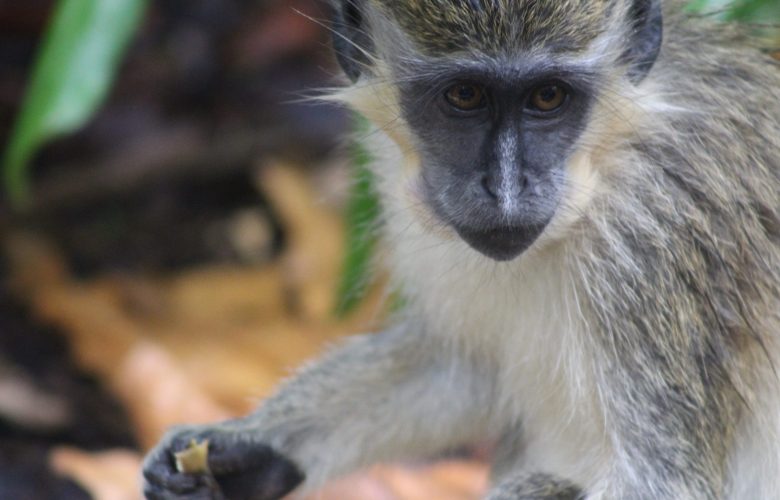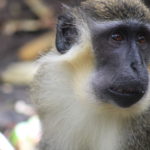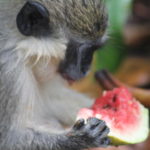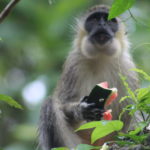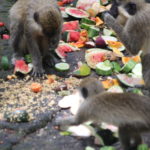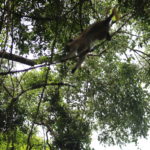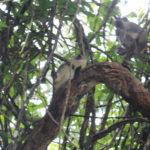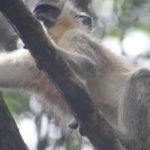Barbados is not well-known for its land based plants and animals. However, according to the National Biodiversity Strategy and Action Plan for Barbados (NBSAP), mammals, birds, reptiles, amphibians and land based insects are the mainstay of biological diversity in Barbados.
In the case of mammals, the only surviving species indigenous to Barbados are six species of bats, and the present mammalian population mainly comprises introduced or alien species. These include rats, green monkeys, mongooses and also the hare (Lepuseuropanus), which is rare and can be sighted in the more rural parishes.
The green monkey (Chlorocebus sabaeus) is from West Africa and was introduced to Barbados in the 17th century. Other Caribbean countries with wild populations include St. Kitts and Nevis, Grenada and Trinidad and Tobago. According to the NBSAP average troop size is 15 and age-sex composition includes 1-2 adult males, 4-5 adult females and their offspring. Their diet is similar to other primates and includes leaves, seeds, fruit, flowers, some invertebrates and vertebrates (rodents, lizards, birds) but their preference is seasonal fruit and flowers. Humans and dogs are their only predators in Barbados. Population assessments in 1980 and 1994 revealed sizes of 14.200 and 14,792 respectively. The monkeys are very adaptive and territorial, and prefer wooded areas for refuge and food. Tree cover in Barbados is minimal compared to land area, and includes gullies, coastal woodlands, us cliff woods and other planted wooded areas. The least disturbed forested area is Turner’s Hall woods, which is located in the parish of St. Andrew
Political Ecology
The management of the green monkey in the Barbadian context is an interesting case study. Barbados has adopted the United Nations Convention on Biological Diversity. The convention speaks to conservation and sustainable use of biological diversity, and the equitable sharing of benefits from its use. A number of Government agencies are responsible for implementing the obligations of the convention, including the Ministry of Agriculture and Rural Development. However, implementation is not supported by a comprehensive legislative framework, including protection of mammals and their habitats.
Barbados is also a party to the Convention of Trade in Endangered Species of Fauna and Flora (CITES) and has passed CITES legislation after a protracted period Implementation is again the responsibility of a number of government agencies. The green monkey is listed in Appendix II of the CITES convention which includes “species not necessarily threatened with extinction, but in which trade must be controlled order to avoid utilization incompatible with their survival.” The Ministry of Environment routinely grants the Barbados Primate Research Centre and Wildlife Reserve (BWR) certificates for export for biomedical purposes. The BWR sources monkeys by trapping in areas where they are considered problematic. The monkey is the only mammal in Barbados with substantial economic value, other than bats as pollinators and dispersers. Use values include biomedical research (using the kidneys of the monkey for polio vaccines) and the non-use value are recreational and tourism related.
Economic and social costs attributable to the monkeys mainly include crop damage and loss of farmer income. In the Daily Nation newspaper of March 8, 2010, it was noted that “monkey raids add to drought woes, highlighting the combined challenges faced by farmers. To mitigate monkey invasion of farms, the Ministry of Agriculture manages a bounty system. As a result, Barbados has the dubious distinction of being one of few the few countries in the world with a bounty policy. Monkeys are shot by licensed firearm operators, and the tips of the tails are removed and submitted to the Ministry of Agriculture for Bds $15 (US $7.5) per tail tip Concerns that have been raised are cruelty to animals and shooting in residential areas. There have also been recent reports of persons capturing and torturing monkeys. The BWR programme was considered a sustainable alternative to the bounty programme.
Paradise Heights Case Study
Paradise Heights, located along the border of St. James and St. Michael, is a middle income residential area of approximately fifty house holds to the north of The University of the West Indies (UWI), Cave Hill campus. To the west of Paradise Heights there is a wooded area, known to residents as “the gully”, which is by the green monkey. “The gully” once was linked via corridors of tree cover to other wooded areas further west, for example, at Batts Rock and Paradise Beach. However, the habitat at Paradise Beach has been completely removed because of the Four Seasons tourism development. The monkey habitat has also been encroached upon by the northward expansion of the UWI. Cave Hill campus, taking up approximately 10-12 acres of land. The combined removal of vegetation has decreased the monkey habitat resulting in more sightings by and interactions with the Paradise Heights residents
Wooded areas to the west of Paradise Heights make up one of the last remaining enclaves for monkey habitation in the urban corridor which runs along the West and South coasts. The limited population of monkeys on the West coast is related to urban sprawl shrinking the amount of wooded area available for refuge. The monkey population in Barbados is mostly concentrated in the eastern rural parishes of St. Andrew, St. Joseph, and St. John because of vegetation in these areas.
The views and perceptions of Paradise Heights’ residents were captured in a survey. The female interviewees mainly found the monkeys to be a pest and this was specifically related to the destruction of property and the eating of fruits. One woman did note, however, that “because of the intrusion of their natural habitat, they are becoming pests.” A coping strategy some people tried involved the use of water from a hose to scare the monkeys. Monkeys were not hunted in Paradise Heights but it was noted that people outside the neighbourhood have asked questions about monkey sightings and the bounty.
Generally, people interviewed were not afraid of the monkeys, however, some women felt some unease and one said “I am not afraid of the monkeys, but I ignore them because if they are encouraged in any way they may become agitated and perhaps bite or attack me”; and another said, “Not really, but it is wise to keep away from them.” The monkeys can be aggressive at times among themselves, destroying tree limbs.
People interviewed also noted that the monkeys are more common now than ever before, especially juveniles, and this increase in sightings and interaction corresponded with the start of the construction of Four Seasons hotel development and the expansion of UWI Responses were varied with regard to protecting the monkeys and the habitat and some women especially questioned the need for protection. For example, one individual noted that “I certainly would not support anyone who wants to protect them and their habitat. That would be folly and a lot of nonsense.” Another woman recommended that all monkeys be caught and taken to the BWR.
The Way Forward
Despite the possibility of alien invasive status and the problem of crop damage, the green monkey has been advertised by the tourism industry as a major component of Barbados’ biodiversity. Therefore, some form of co-existence with residential areas has to be considered. It is, therefore, recommended that the remaining wooded area to the west of Paradise Heights and north and west of UWI be protected for the monkeys. Fruit tree propagation could be embarked upon as a partnership between the UWI’s botany department, and the Ministries responsible for Tourism and Agriculture. The University of the West Indies can also use the “reserve” as a field class habitat for research in behavioural traits of urban monkey populations, and introductory monitoring exercises. Residents could also be constantly updated through emails and newsletters about the population and behaviour. CX
By Kwame Emmanuel
First published in CX vol 1, Issue 3, 2010/11
Photos by Ian Boxill.
